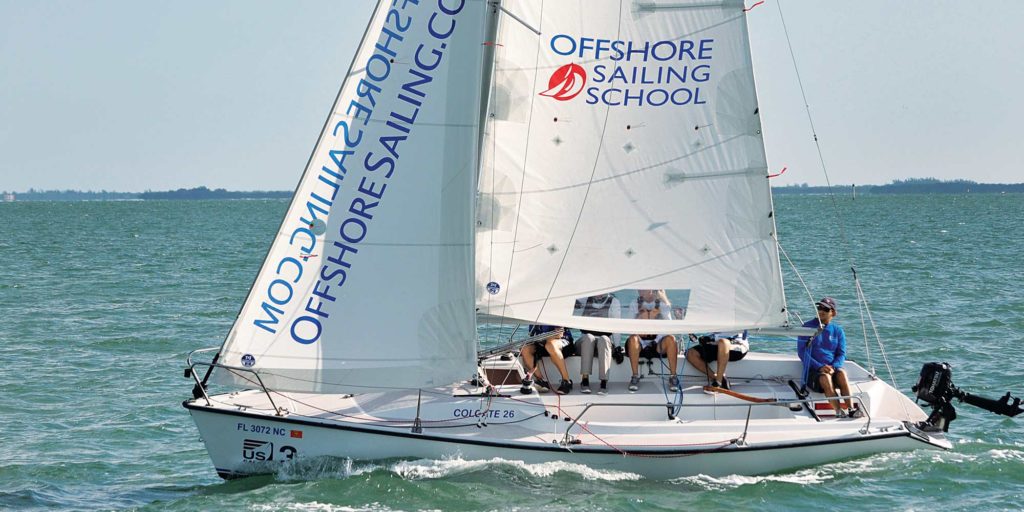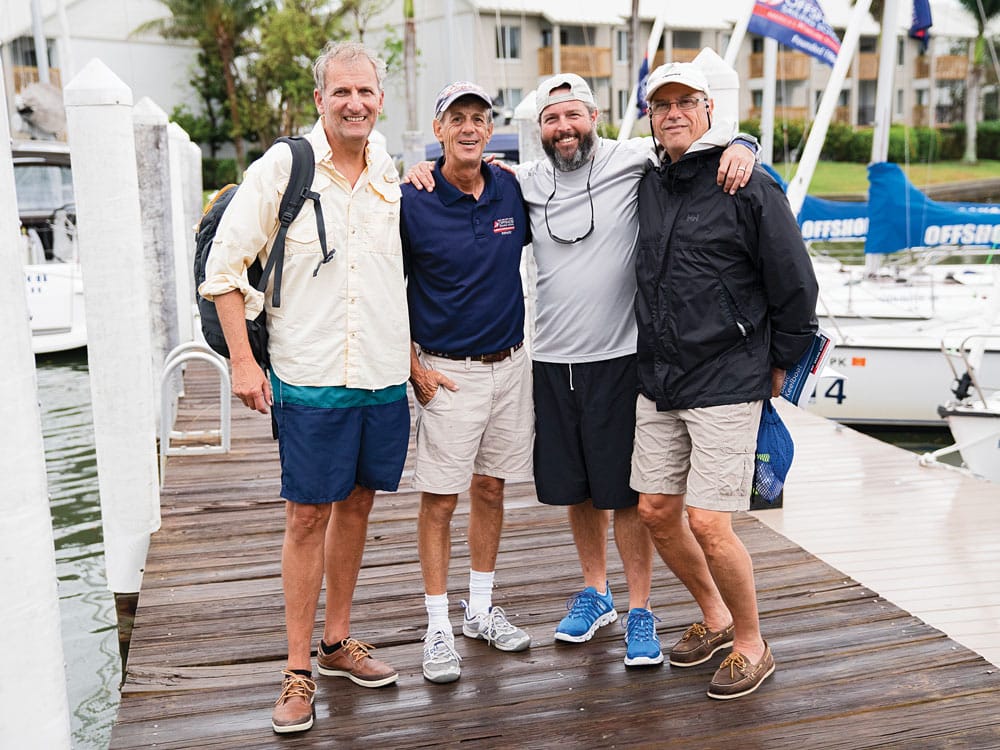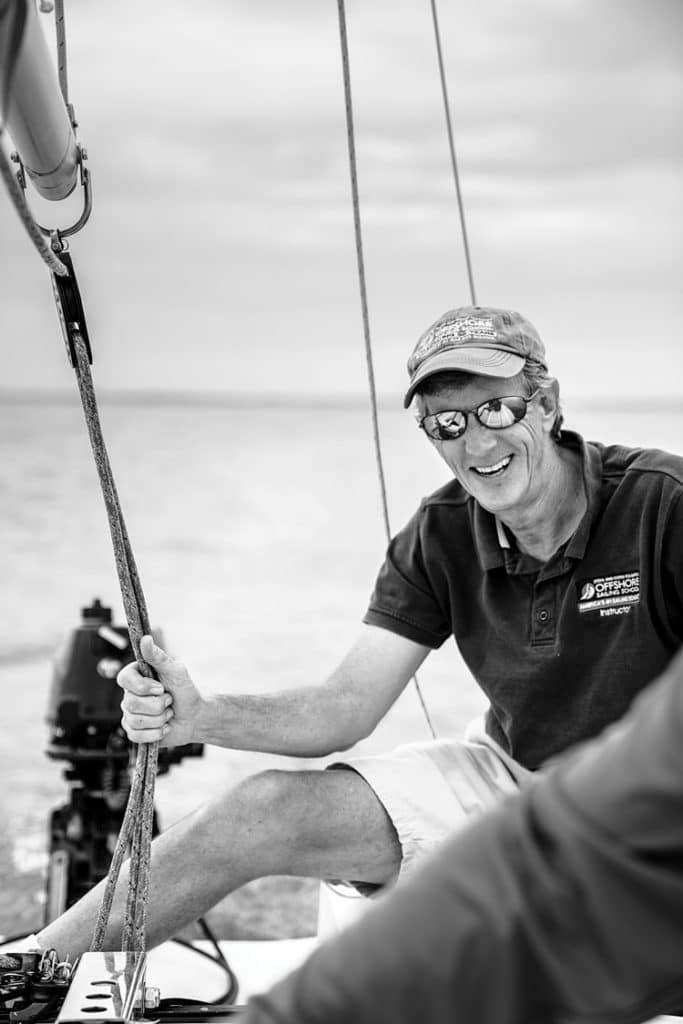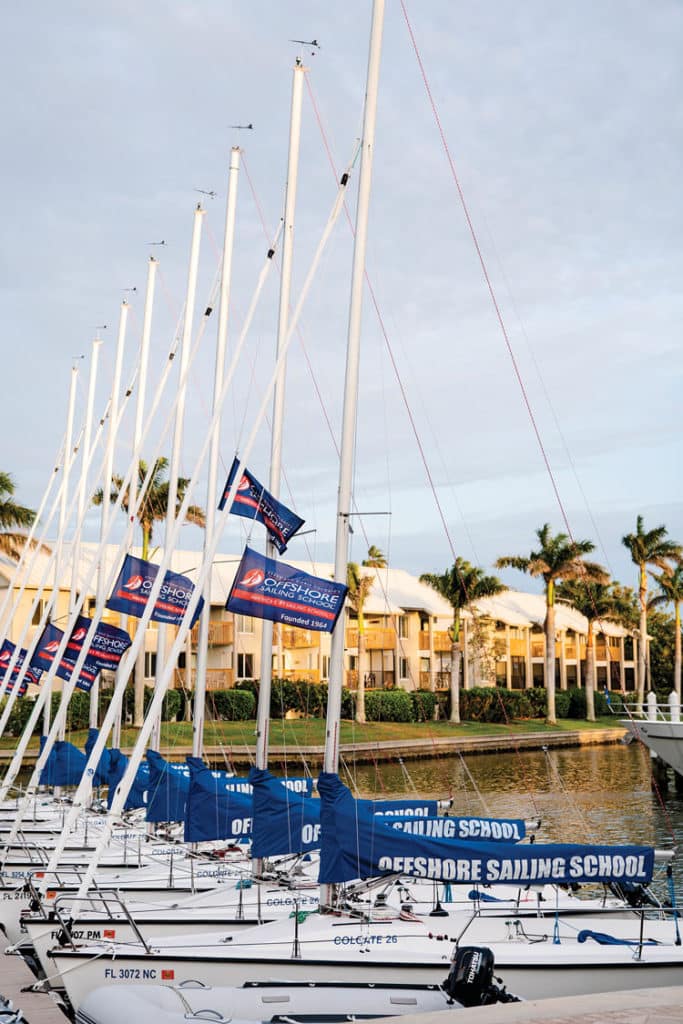
Lightning lashed the ground somewhere over the mainland of the Florida peninsula, signaling that our day on the water was rapidly coming to an end. I was seated on the starboard-side of a Colgate 26 with four other people, three of whom were, like me, sailing students. Each one of us glanced sharply upward as an ominous clap of thunder growled across the sky. This was my home-state summer weather, and I was prepared for the impending rainstorm that was tiptoeing our way from the western shore. I was far less prepared when Kurt, our sailing instructor, shimmied slightly to port and offered me the tiller. He shouted above the rising wind: “All right, Jon, it’s your turn to take the helm.”
I’d been at this for two days, but still a nervous excitement took hold of me as I moved into position. Kurt crept dexterously aft until he was perched upon the transom like a cat. I took the tiller into my hand and immediately looked upward toward the Windex. I noted the direction and pushed slightly away on the worn wooden handle. My eyes drifted across the sail in search of the tiny telltales, and I found them lying limp against the canvas. Another tongue of lightning licked at the surface of the water. I adjusted further, searching for the perfect angle. I could feel that I was on the right track — the pressure against the rudder just felt right. The correct point of sail was realized, and the telltales began streaming perpendicular to the mast. I felt the agile boat respond to the wind and the steerage, and suddenly… I was sailing.
I should pause here for a confession. I am not a sailor. In fact, I’m a recovering throttle-holic. I grew up on the sun-blanched coast of southeastern Florida where both shores of the Intracoastal Waterway are lined with docks adorned with powerboats. I was a spear-fisherman, a water skier, a sun-kissed kid that would someday be a dermatologist’s gold mine. But I had never set foot on any vessel without a rod rack or ski boom. Sailboats were little more than triangular silhouettes on the horizon. They were the quietly ghosting shadows that always seemed to have right of way. They were never my destiny. Or so I thought.
Somewhere during my career as a staff photographer for a magazine group, I was assigned to shoot for Cruising World. I knew it would be an easy assignment — how hard could it be to snap pictures of salty sailors gripping oversize wheels? And so I spent a brisk day in Annapolis, Maryland, shooting all manner of boats, chuckling to myself as I crushed every shot. That night I swung my laptop around to editor Mark Pillsbury to show him the spoils. It was a struggle to contain my confident smile. Mark looked at each revelatory shot, nodding quietly. When he finally spoke, I prepared to let the compliments rush over me.

“These are pretty much unusable,” he said. “You just wouldn’t ever shoot a boat from this angle.” I had no smile to hide now. He continued: “And you see this one here, the sails are luffing. Doesn’t look very good for a photo.” Mark has a calm way about him, one that makes even the harshest of criticism sound like a friendly suggestion. But there was no mistaking the underlying sentiment in his very accurate assessment of my skills. “I think you need to learn how to sail.”
RELATED: Best Learn to Sail Books
Fortunately for me, the Steve and Doris Colgate Offshore Sailing School is based here on the peninsula in Fort Myers. This esteemed institution was founded in 1964 by Steve Colgate who earned his sailing chops both as an Olympic and America’s Cup sailor, and was recently inducted into the National Sailing Hall of Fame. Not only did Steve write the school textbooks, but he even designed the iconic vessel upon which students learn: the nimble Colgate 26. Steve’s wife Doris is no slouch either — she is the CEO and president of Offshore Sailing School, as well as the founder of the National Women’s Sailing Association and a respected sailing author. The combined forces of these two powerhouses have produced one of the most comprehensive and respected sailing education centers in the world. And somehow I was lucky enough to secure a seat. The entire enterprise is composed of four resort-based locations in Florida and two more in the British Virgin Islands on Tortola and Scrub Island. I chose to learn at the Captiva Island location, because why not go to school in paradise?

There are many courses to choose from, and if one was so inclined, it would be possible to learn the basics and continue all the way to offshore passagemaking and performance racing. Being a sailing idiot, I was confined to the most basic course available: Two-Day Learn to Sail. From the title of the course you may have gathered that this is a quick class, structured with morning and afternoon lectures with bouts of sailing between. The Colgate school is really based on two principles: learn by doing and learn by watching others do. The majority of the curriculum takes place exactly where you might expect it — on the water and in the wind. Each vessel is manned by four students and one instructor, with students taking turns at the helm and on the lines. The lessons here are learned by experiencing each other’s mistakes and successes under the watchful gaze of a knowledgeable tutor.
I was lucky enough to be paired up with instructor Kurt Martin, a thin, wiry man whose eyes flashed with a joyful evil while he gleefully described the havoc he delivered upon opponents when racing sailboats. In his off-time, he makes and repairs sails and even races miniature radio-controlled boats. Kurt’s head was always adorned with a tattered baseball cap that shaded a face that’s seen many hours of sun. He spoke on sailing with both authority and a sense of humor, unafraid to call out the mistakes he saw students making while giving pats on the back when things went just right. It was a way of teaching that allowed a path to knowledge gleaned by the student’s own observations and experience on the water.
Upon registering for a class, your study materials are sent to you by mail, and it’s strongly suggested that you read them ahead of time. I, of course, did not. But even being the terrible student that I am, the lectures were delivered in a way that allowed me to follow along perfectly. A scale replica of the Colgate 26 in the classroom served as an effective visual aid for learning not only the physical aspects of the vessels, but also how the moving parts work together. I learned to tie a bowline and a hitch. I learned about the physics of wind and how it can be harnessed. Two days prior, I thought Bernoulli was a brand of olive oil, but suddenly I understood how that principle allows us to defy direction and sail against the wind. I also learned that sailors truly hate common names for everything. A floor is a sole, a door is a companionway, a rope is a line, and god forbid if you try to go to the “front” or the “back.” But even more interesting was the international origin of so many sailing terms. Who knew that “boom” came from a Dutch word meaning tree? Don’t get hit by the tree. And slowly — very slowly — the basics of sailing began to take root in the fallow garden of my brain, but where it really came together was out on the water.

After almost two decades in my career as a photographer, my mind has been fundamentally broken in a way that only allows me to see things in photographic terms. A quick example: I see the world in a frame whether or not I’m looking through a camera. Everything I see is just a moving composition. Usually my right-brained existence causes issues when trying to negotiate the left-brained world, but a strange thing happened on the waters off Captiva. I came to find that there are a great many similarities between sailing and photography, the most significant being this: In both pursuits, one must harness something invisible and learn to use it in the most efficient way possible. You can’t see the wind, and you can’t see light itself. We identify and interact with both of these forces not by direct observation, but by observing their effect on objects in the world. When the sun is low and angled, the world is alight with a warm, orange glow — it’s the effect of that invisible force reflecting off of objects and presenting in colors that allows us to describe it. In terms of sailing, it’s much the same. Ripples on the water reveal a puff in the distance; telltales describe the path of wind around the curve of a sail; trees and flags fluttering on shore can suggest wind strength, while the Windex above identifies direction. By watching the signs given to us by something we can’t see, we learn how best to manipulate it. And in both cases, we can only use what the universe provides — there’s no controlling wind or light. With this a-ha moment, combined with the classroom education, I was finally understanding.
Back on the water, we were on a run, heading downwind toward the harbor. I was careful not to accidentally jibe, and my fellow students had the mainsail perfectly trimmed. Kurt was quiet for a moment, just enjoying the breeze and the cooling drops of rain as we raced away from the encroaching summer storm. At the end of the day, I received my Basic Keelboat certification, the first step in a new journey. I don’t know how far I’ll take this newfound skill and passion, but for now, I’m content in just letting the wind take me where it will.
Jon Whittle is a photographer whose work has appeared in magazines including Islands, Flying and Cruising World. View his work at jonwhittle.com.








